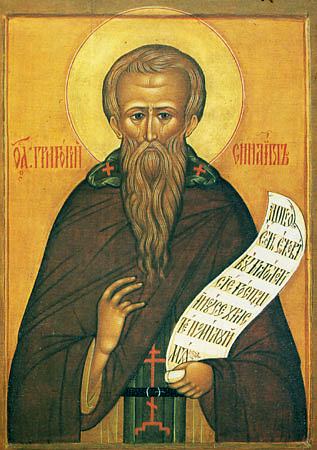Gregory of Sinai, monk, venerable
Dates of commemoration
(Church calendar - Jun 5) Synaxis of all venerable and holy Fathers of the Holy Mount Athos (movable feast on the 2nd Sunday of Pentecost)
Life
Saint Gregory of Sinai was born around the year 1268 in the seacoast village of Clazomenia near the city of Smyrna (Asia Minor), of rich parents. In about the year 1290, he was taken into captivity by the Hagarenes and sent off to Laodicea.
After gaining his freedom, the saint arrived on the island of Cyprus, where he was tonsured a monk. He set off afterwards to Mount Sinai and there assumed the great schema. Having fulfilled his obediences of cook and baker, and then as copyist, surpassing all in reading and knowledge of Scriptural and patristic books.
The strictness of his life (fasting, vigil, psalmody, standing at prayer) brought some to astonishment and others to envy. Departing the monastery, the monk visited Jerusalem. For some time he lived on the island of Crete, and afterwards he visited Mt. Athos with its monasteries and ascetics. In this way, he acquired the experience of many centuries of the monastic life from the ancient monasteries. Only after this did Saint Gregory the Sinaite settle himself in a solitary place for “hesychia” [stillness doing the Jesus Prayer], a cell for silence and the unhindered pursuit of mental prayer, combined with hard work.
The precious legacy of Saint Gregory is in his teaching about the inner life, 15 texts “On Stillness,” and 137 texts “On Commandments and Doctrines,” where he says that “trying to comprehend the commandments through study and reading without fulfilling them, is like mistaking a shadow of something for its reality” (“On Commandments and Doctrines,” section 22).
He is renowned also as a remarkable hymnographer (“It is Truly Meet” is ascribed to him), and a canon to the Most Holy Trinity read at Sunday Vigil, and a canon to the Holy Cross. In a book of canons (from the year 1407) of Saint Cyril of White Lake (June 9) is found the “Canon of Supplication to the Lord Jesus Christ, the work of Gregory the Sinaite.”
Because of his concern for the spreading of monasticism, the saint founded several cells on Athos, and also four monasteries in Thrace. Saint Gregory the Sinaite died in the year 1310 (some historians suggest the year 1346) at his so-called “Concealed” (“Parariseia”) monastery, founded on Mt. Paroria on the west coast of the Black Sea for the strict followers of his life.
Source:
https://oca.org/saints/lives/2017/08/08/102237-venerable-gregory-of-sinai-mt-athos
Holy relic type
unless specified otherwise below, "holy relic" means a fragment of a bone of the saint
Holy relic
Location of the holy relic in the Cathedral:
North kliros, reliquary #2
Troparion
Общий тропарь преподобному, глас 1:
Пустынный житель и в телеси Ангел / и чудотворец явился еси, богоносе отче наш (имярек), / постом, бдением, молитвою Небесная дарования приим, / исцеляеши недужныя и души верою притекающих ти. / Слава Давшему ти крепость, / слава Венчавшему тя, / слава Действующему тобою всем исцеления.
Иный тропарь преподобному, глас 8:
В тебе, отче, известно спасеся еже по образу: / приим бо Крест, последовал еси Христу, / и дея учил еси презирати убо плоть, преходит бо, / прилежати же о души, вещи безсмертней, / темже и со Ангелы срадуется, преподобне (имярек), дух твой.
Иный тропарь преподобному, глас 8:
Слез твоих теченьми пустыни безплодное возделал еси, / и иже из глубины воздыханьми во сто трудов уплодоносил еси, / и был еси светильник вселенней, / сияя чудесы, (имярек), отче наш, / моли Христа Бога спастися душам нашим.
Kontakion
Общий кондак преподобному, глас 2:
Чистотою душевною божественно вооружився, / и непрестанные молитвы, яко копие, вручив крепко, / пробол еси бесовская ополчения, / (имярек), отче наш, / моли непрестанно о всех нас.






